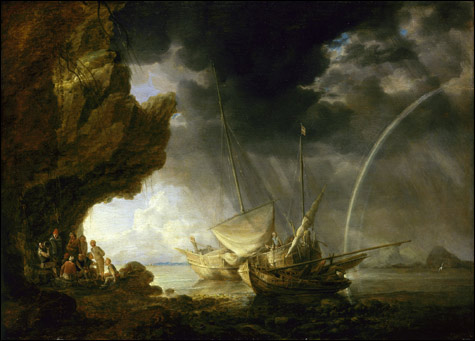
Bonaventura Peeters the Elder, Seascape with Sailors Sheltering from a Rainstorm |
There's no question about the Peabody Essex Museum's unwavering love of all things nautical. How many other museums employ a curator of maritime art and history (in this case, Daniel Finamore)? Opening June 13, in its only American venue, "THE GOLDEN AGE OF DUTCH SEASCAPES" will present 70 paintings by 15th- and 16th-century Dutch masters enamored of big ships and the aquatic bodies they sailed through.
Organized by the National Maritime Museum in Greenwich, the show was an easy sell to the Peabody Essex, which in the past three years has hosted three sea-centric exhibitions ("To The Ends of the Earth: Painting the Polar Landscape," "Sketched at Sea," and "The Yachting Photography of Willard B. Jackson"). This show, however, raises the bar, with work created "in the time of Rembrandt and Vermeer . . . during the peak years of Dutch achievement between 1600 and 1700."
"Dutch Seascapes" concentrates on the moment when the Netherlands' painters — here also including Ludolf Backhuysen, Jan Porcellis, Jacob van Ruisdael, and Simon de Vlieger — began to focus attention to light and color on harbor settings, maritime narratives, and oceanic weather conditions. Bonaventura Peeters the Elder's Seascape with Sailors Sheltering from a Rainstorm (1640) has bands of sun extending from black clouds amid rolling waves and a remarkably dark palette — casting light, so to speak, on the treacherous conditions men endured for the sake of trade and discovery. The techniques used in these works, the museum points out, later served as the foundation for maritime work currently in the collection of the Peabody Essex.
Opening June 20 at the PEM will be "TRASH MENAGERIES," an exhibition of art made with discarded and recycled materials, each in the shape of — you guessed it — an animal. Using miscellaneous electronic parts, old cigarette filters, and other found objects (many from their back yards), the 24 artists have created sculptural works that resemble camels, butterflies, dogs, and the like. The result not so casually evokes the hot-button polemic of environmental impact while demonstrating that junk, in any state, is junk (but it can also be a bunny). The show and related events (which include a screening of WALL•E) are geared toward kids, but parents will have fun explaining what a carbon footprint is and why their child can't see it.
"THE GOLDEN AGE OF DUTCH SEASCAPES" | June 13–September 7 | "TRASH MENAGERIES" | June 20–May 2010 | Peabody Essex Museum, East India Square, Salem | 978.745.9500 orwww.pem.org